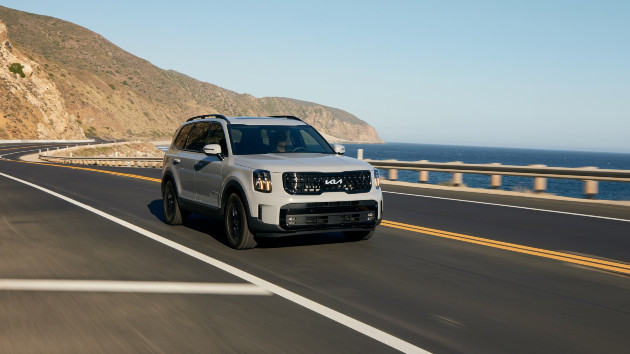How Kia's design chief is making Americans want to drive sedans again


(NEW YORK) — Kia’s K4 sedan, a sleek, compact four-door that debuted this week at the New York International Auto Show, has stiff competition — mainly from the Korean brand’s own sport-utility vehicles and crossovers.
American drivers, however, may soon become enamored with the sedan’s fastback styling and airy interior.
“We’re not all going to drive SUVs … people have different tastes and needs and desires,” Karim Habib, the head of Kia Global Design, told ABC News. “We wanted to make the sedan relevant for the future.”
Habib joined Kia in 2019, overseeing the brand’s exterior, interior, color and material teams. He’s also behind Kia’s “Opposites United” design strategy, which has helped Kia become a household name in the U.S.
The marque has received rave reviews for its EV6 and EV9 electric vehicles, Carnival minivan and Telluride SUV, and many Americans are now choosing Kia over its American competitors.
Habib spoke to ABC News about the brand’s direction, how autonomous vehicle technology is changing vehicle design and why Americans love their boxy SUVs so much.
The interview below has been edited and condensed for clarity.
Q: How would you describe Kia’s design strategy in three words?
Karim: Our design strategy is called “Opposites United.” It is really about embracing the contrasts in life. There are contradictions and unexpected surprises that happen every day … and that’s what makes life enriching, beautiful sometimes, what makes it poetic. That’s what we’re trying to do in an abstract way if you will.
Q: OK, so translate that philosophy to a car.
Karim: Our new K4 is a compact sedan. We tried to make it feel as lean, as sleek, as athletic, as elegant and dynamic as possible. It’s very much about horizontality, where we pull the lines from one side of the car to the other. But the contrasts are vertical, strict graphics. We combined flowing lines, surfaces with very rigid lines. And that pairing is maybe an example of “Opposites United.”
Q: What is your favorite vehicle type to design? An SUV? Sedan? Sports car?
Karim: Each one has its challenges. And each one has its little nuggets of fun that come with it. I would say everything. For me, designing things like a pickup or a van — things I haven’t had much experience with in the past — these are things that I really enjoy doing.
Doing a super sports car is also quite challenging. A car or vehicle with a very, very tight budget can also be a really creative process. I am quite lucky to be a car designer. There’s a lot of fun to be had in many of these segments.
Q: SUVs have gotten bigger over the last few years and the boxy design is in — your EV9 is one example of that. How long will the boxy trend last and how else can SUVs evolve in terms of exterior design?
Karim: The most important thing about design is being authentic. Good industrial design is authentic. That’s why boxy SUVs will always work. It’s a concept that’s meant to be about carrying people in comfort and safety … about having space. The boxy concept just makes sense. And it works particularly well now because we found ways, with technology, to do a box — but to do a cool-looking box, where you have big wheels, a long wheelbase, short overhangs. It’s still a box and looks great. If you look at old Jeeps and Defenders and Land Cruisers — these kind of vehicles were [a box]. So we have that type of connection to these types of architectures.
Q: Do you look back on your designs and say, I should have tweaked this or that? What would you change, if anything, about the EV9?
Karim: To answer your first question: All the time. I don’t think any creative … should be totally satisfied with their work. Designers always think we can do something better.
In the case of the EV9, it’s perfect [he laughs]. No, I am kidding. But I will not reveal it now.
Q: Kia’s vehicles — especially its electrics like the EV9 and EV6 — are getting more Americans interested in the brand. How important is a vehicle’s styling to a consumer?
Karim: Design has strategically been a part of our company’s philosophy, our macro strategy, for a while now. For our consumers, it’s really important to them in the purchasing decision. Design is always very high on the list. Obviously I am not very objective, but I do believe it’s extremely important.
I don’t believe we just style. I believe we try to think of how the product is used and how to improve the type of products … to make the customer experience better.
If we develop [products] in a way that makes the user’s life better and easier — in our case more comfortable and safer and more pleasant — then I believe we have improved people’s lives. And that’s good design in my opinion.
Q: Where are you taking the brand in terms of design?
Karim: We want to be a sustainable mobility provider. Our responsibility toward the environment is very important. It’s important to the brand and it will be very much in the future. To be able to provide a safe, nicely designed, comfortable object that’s affordable … that’s really what we’re about.
Q: A large percentage of Americans drive trucks and SUVs. Was there extra pressure to make the K4 a sexy or attractive sedan to the U.S. buyer?
Karim: I would say this: We believe that sedans are relevant and should be relevant in the future. Not everybody will want the same thing. We’re not all going to drive SUVs … people have different tastes and needs and desires. We need variety. And we wanted to make the sedan relevant for the future. So making it aspirational, something you wanted to have, was important to us. Maybe that’s why we wanted the K4 to be more sporty, more dynamic, more elegant.
Q: Another design trend that’s becoming more popular, especially in EV concepts: no steering wheels, no gear shifters, no side mirrors. What’s your take?
Karim: Autonomous driving technology is obviously coming. Sometimes we think it’s going to come faster, sometimes we think it might come slower, but it will come. And that requires new thinking. It requires us to reconsider the way we create the space that you live in when you move from A to B.
The technology that comes with it also requires you to design differently. There are lots of sensors and cameras and radars and lidars, so the exterior of cars is also going to change quite a bit because of that.
Yeah, it’s a trend — a movement, an evolution, that will come. We are just in the process of learning what it’s really going to be like for us designers.
Copyright © 2024, ABC Audio. All rights reserved.






